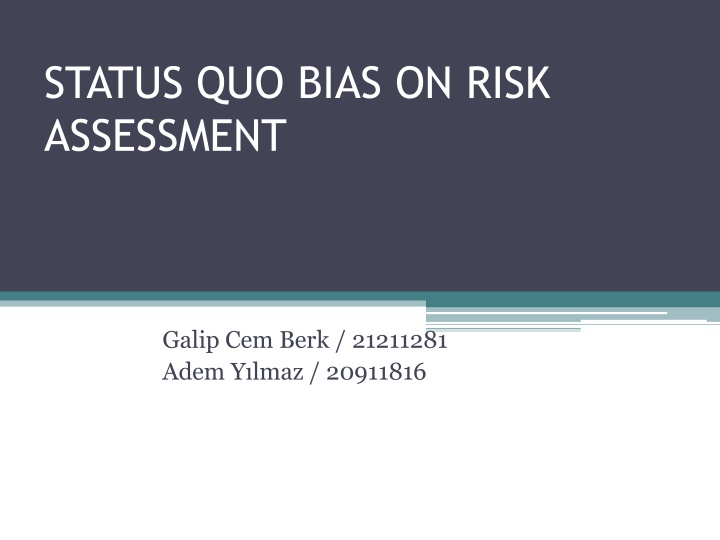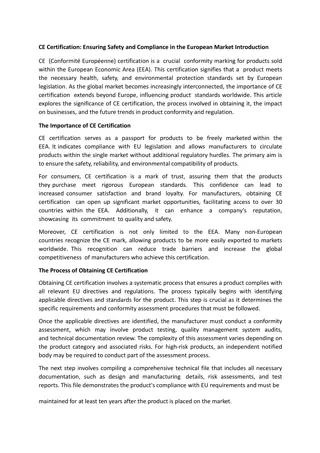
Risk Assessment and Status Quo Bias Study Results
Explore the implications of status quo bias on risk assessment through an experimental study involving 50 students. The experiment investigates how people perceive risk under different default options and presents insights into decision-making processes related to potential loss and gain. Detailed analysis and statistical modeling of collected data shed light on participants' choices based on gender and success/failure outcomes.
Download Presentation

Please find below an Image/Link to download the presentation.
The content on the website is provided AS IS for your information and personal use only. It may not be sold, licensed, or shared on other websites without obtaining consent from the author. If you encounter any issues during the download, it is possible that the publisher has removed the file from their server.
You are allowed to download the files provided on this website for personal or commercial use, subject to the condition that they are used lawfully. All files are the property of their respective owners.
The content on the website is provided AS IS for your information and personal use only. It may not be sold, licensed, or shared on other websites without obtaining consent from the author.
E N D
Presentation Transcript
STATUS QUO BIAS ON RISK ASSESSMENT Galip Cem Berk / 21211281 Adem Y lmaz / 20911816
Status Quo Bias , a preference of the current state of affairs. An implication of loss aversion Samuelson and Zeckhauser (1988)
Methodology A ball was thrown to a bin by subjects whether using the dominant hand or non-dominant hand. To percieve their risk assessment and the effect of status quo relationship, videos were shown to random groups and rewards are given for scores.
Experiment was done by the participation of 50 students. In 4 days we have reached to required data. Collected data was processed with the relevant statistical programs, models were constructed and the results of each interpreted.
REWARD Dominant Hand Non-Dominant Hand
Utility Percepiton Potential Loss Potential Gain
Purpose The experiment examines how people make the assessment of risk under the effect of default option.* Choice Gender Success/Fail
Sample Profile Age : 18-26 Gender: 50 % 50 % Female Male
Results Model 1: Logit, using observations 1-50 Dependent variable: Choice Standard errors based on Hessian coefficient std. error ----------------------------------------------------------- const 0.575364 0.416667 1.381 0.1673 DefaultOption 1.72804 0.626825 2.757 0.0058 *** z p-value
CHOICE (ND as Default Option) 36% D 64% ND
Model 1: Logit, using observations 1-25 Dependent variable: Choice Standard errors based on Hessian coefficient std. error z p-value ----------------------------------------------------------- DefaultOption 0.575364 0.416667 1.381 0.1673
CHOICE (D as Default Option) 24% D ND 76%
Model 1: Logit, using observations 1-25 Dependent variable: Choice Standard errors based on Hessian coefficient std. error z p-value ---------------------------------------------------------- DefaultOption 1.15268 0.468293 2.461 0.0138 **
Correlation between Default Option and Choice corr(Choice, DefaultOption) = 0.40291148 Under the null hypothesis of no correlation: t(48) = 3.04997, with two-tailed p-value 0.0037
Correlation between Gender and Success corr(Gender, SuccessFail) = -0.04364358 Under the null hypothesis of no correlation: t(48) = -0.30266, with two-tailed p-value 0.7635
Correlation between gender and choice corr(Gender, Choice) = 0.08058230 Under the null hypothesis of no correlation: t(48) = 0.560112, with two-tailed p-value 0.5780
Observation of the Magnitude of Bias by Gender
Male Model 2: Logit, using observations 1-25 Dependent variable: Choice Standard errors based on Hessian coefficient std. error ----------------------------------------------------------- const 0.693147 0.612372 1.132 0.2577 DefaultOption 1.50408 0.857969 1.753 0.0796 z p-value
Female Model 1: Logit, using observations 1-25 Dependent variable: Choice Standard errors based on Hessian coefficient std. error ------------------------------------------------------------ const 0.470004 0.570088 0.8244 0.4097 DefaultOption 2.07944 0.961769 2.162 0.0306 z p-value
Probabilty of Making Status Quo Bias by Gender (Male) Male Default Option New Option 32% 68%
Probabilty of Making Status Quo Bias by Gender (Female) Female Default Option New Option 28% 72%
Conclusion As we had expected before our experiment the presence of the default option led people to be affected by Status Quo bias. We observed the correlation between default option and choice datas while there was not among other variables in our model.






















